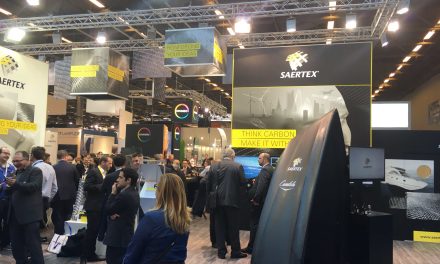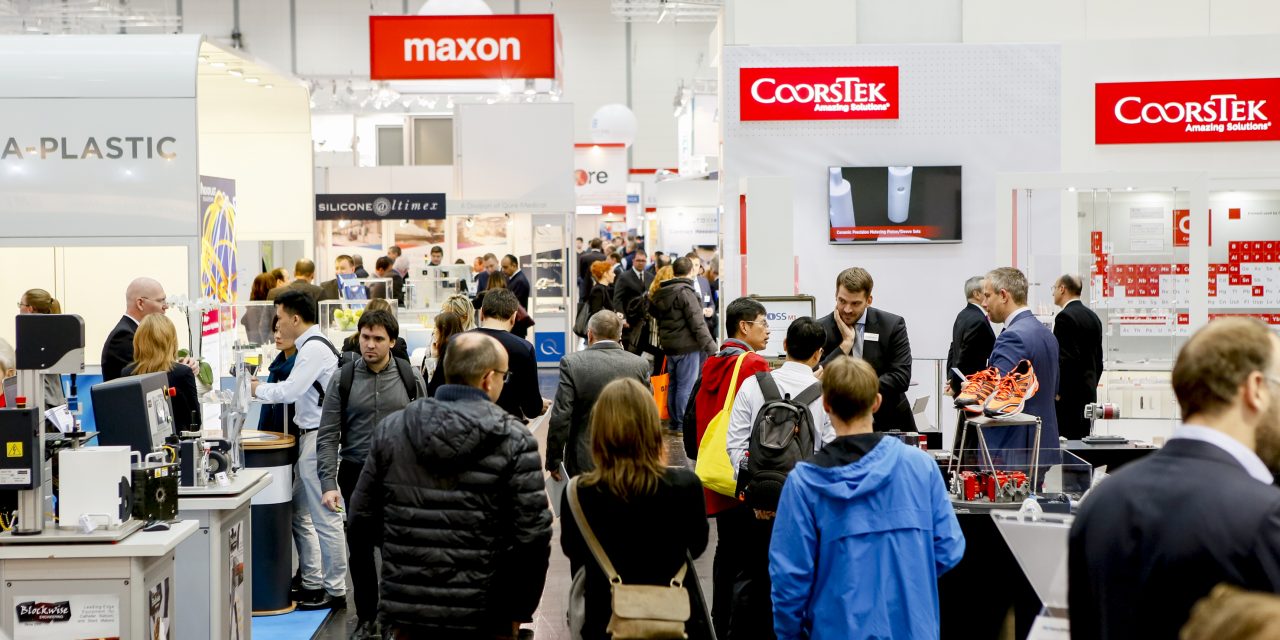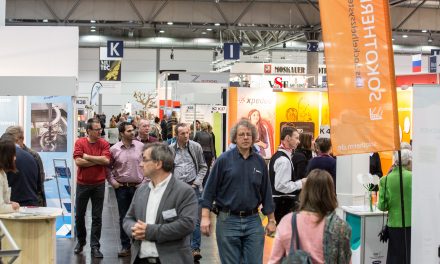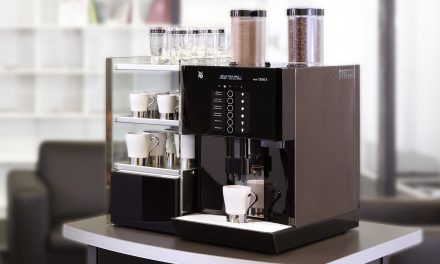“Together we are strong” – this slogan describes the lively atmosphere and intensive programme of events at COMPAMED 2016 in Düsseldorf (14 – 17 November) perfectly. This year, it was more obvious than ever before that suppliers and their partners from the medical technology industry, who presented themselves as service providers at the world-leading medical trade fair MEDICA 2016, which ran in parallel to COMPAMED and had over 5,000 exhibitors, are looking to find partners for close cooperation in product development, manufacturing and marketing. Furthermore, clients increasingly expect their suppliers to provide complete end-to-end solutions which encompass everything from the initial idea to the end product, potentially in sterile packing. Of a total of 127,800 trade visitors that attended both events, 19,000 were particularly interested in the topics broached at COMPAMED 2016 and its 774 exhibitors, located in Halls 8a and 8b.
From mobile systems for multi-parameter analysis in point of care diagnostics to packaging systems that take up entire rooms, from antibacterial cables to the world’s smallest differential pressure sensor – once again the suppliers have shown that they can fulfil an entire range of needs.
Currently, users are looking for small electronic devices in particular, otherwise known as wearables. Wearables are becoming a market that is earning hundreds of billions worldwide. The best known wearables are the small armband-watches, i.e. sports armbands. The market for microcomputers which can be attached to the skin like a sticking plaster is also developing at the speed of light. The magazine “Wearable Technologies” predicts that the current annual sales of around 200 million units will double by 2019. At that point, the annual sales volume of electronic “lifestyle aids” will reach 4.4 billion US dollars. Synthetics manufacturer Covestro has come into the market at exactly the right time and presented a complete solution of customised polyurethane films as well as raw materials for adhesives and foam. “With these exquisite materials we can create thermoplastic films that can manifest any required characteristic – in terms of processing speed, flexibility and cost – so that we can carry out roll-to-roll processing”, explains Martin Hüttner, Head of Medical Marketing at Covestro. The adhesive, a two-component system, makes it possible to calibrate the adhesive strength so that is perfectly geared to placing on babies’ sensitive skin or for keeping wearables on for several days.
Microsieves for cancer diagnosis and stem cell research
Covestro present themselves as a system provider, and similarly Temicon also delivers client-specific membranes and microfilters made from metal and polymer materials, under the slogan “all in one”. The output process for the tiny microstructures is UV lithography. “We offer our clients the entire process chain – from design through the lithographic process to the master, through galvanising and finally producing the synthetic replication via UV imprinting technology using injection moulding”, states Dr Stefan Wiebach, Global Sales & Marketing Director at Temicon. In this way, incredibly precise microsieves can be manufactured for stem cell research, for example, and also for cancer diagnostics. Wiebach and his team are particularly proud of their production of tapered pores, which taper from 20 micrometres at their opening to five micrometers and which enable certain types of cells to be selectively “fished out”. “To our knowledge, this technology is unique”.
In comparison to Temicon’s microscopic structures, the machines from Zwick are gigantic. On the Zwick stand in Hall 8a, for example, one of these machines demonstrated “push and turn testing” on a child-safe screw cap which was almost as tall as a person. The business specialises in material and component testing, which is also very important for the medical technology community. “Our range goes from individual material testing machines to order verification. We supply the relevant machines, which are constructed in modules, and we provide the respective services”, says Peter Schwenk, Application Engineer at Zwick. Packaging is not the only thing to be tested. Biomaterials to be used for synthetic and natural tissues, therapy systems such as catheters, syringes, cannulas and phials or medical textiles and wound care products can also be checked. “An important point for all of our processes is the consistent, reliable and reproducible documentation of our trials. In this specific respect, the requirements for medical technology are substantially higher than those for other fields”, comments Schwenk.
From idea to end product – everything from a single source
The trend for complete system solutions “from a single source” is also applicable, to a certain extent, to Kugler, a global leading manufacturer of ultra-precision machinery, who came to COMPAMED as an exhibitor for the very first time this year. From engineering to simulation to production, Kugler has the entire range of know-how covered. The new generation of micro-processing “Microgantry” machinery enables, for the first time, the almost serial manufacture of tiny structures with high precision directly from the 3D model. With the closed CAD/CAM chain, the integration of machine-based measuring equipment as well as a regular calibration of the machine axes, which ensures that precise processing points are kept even if the tool or the workpiece is rotated, submicron precision can be attained. “We process different materials and manufacture moulding tools for mass production, depending on their purpose in medical technology such as, for example, analysis in labs-on-a-chip”, explains Till Kugler, the company’s CEO. In addition, the company produces, among others, precision components for endoscope manufacturing, polygon scanners for investigation and laser treatment of eye defects, micro-focusing mirrors and complete systems for laser beam guidance and delivery. “We construct tools which, at 20 microns, only measure around a fifth of a human hair in size, and whose process precision is at under 0.5 microns – only a handful of companies have managed to attain this worldwide”, states Kugler proudly.
Electronics have been an essential ingredient in medical technology for decades. They must be highly protected, especially when they are used in proximity to or on the body, or even implanted inside as they may come into contact with blood, urine or sweat. The required cleaning can be carried out in a washing cycle with an alkaline solution followed by sterilisation in an autoclave. Turck duotec offers direct overmoulding for electronic equipment that needs to be protected for such cases. “We position the electronic device carefully and then overmould it with special synthetics which are biocompatible, hydrolysis-stable and temperature and chemical resistant” says Michael Penzel, Sales Engineer at Turck duotec. Thermoplastics, hot melts and thermosetting polymers are used in overmoulding, depending on the required chemical and mechanical properties for each specific project. Short cycle times and immediate further processing of the parts save the client money in manufacturing costs, and no housing parts are needed. In comparison to casting, direct overmoulding is cost-effective at a lower quantity, starting at only a few hundred items.
In full flow – energy supply, a constant hot topic
An ever-present topic at COMPAMED is the energy supply for portable medical devices, for example defibrillators, patient monitors or blood pressure measuring devices. All cordless devices need energy. Dynamis, a manufacturer of batteries and accumulators as well as a comprehensive developer of universal battery management systems, including hardware and software, is taking care of this aspect of medical technology. “Most of the cells we buy are lithium-ion system based and from renowned manufacturers such as Samsung, Panasonic or LG. We then carry out packaging, management and testing of these custom-built systems”, says Joseph Pfeil, Sales Manager at Dynamis. One huge advantage is that they have their own test laboratory in which transport safety, safety requirements for use in application and suitability for medical use can be tested. “This is how we test the quality of all batteries on the market and reject those that do not fit our applications perfectly,” states Pfeil.
Wireless energy transfer
Speaking of power supply: Scientists from the Fraunhofer Institute for Biomedical Engineering (IBMT) have developed a demonstrator that powers active implants wirelessly via ultrasound. This technology is an alternative to integrated batteries and induction. Specific advantages: It saves space and is more efficient. Ultrasound waves penetrate the metal housing of the implants more easily than electromagnetic waves – ultrasound waves thus have a longer range within the body. The demonstrator, designed as a technology platform, can be adapted for a variety of applications and model variants. Its power supply functions with and without a battery. It can also be configured for a large range of applications for active implants. Examples of applications are common diseases such as high blood pressure, diabetes or Parkinson’s disease. The researchers have developed a complete system consisting of the transmitter outside the body and the receiver contained in the implant. This solution also falls well below the stipulated regulatory limits for ultrasound treatments on the human body. “At the trade fair, we are on the lookout for industry partners in order to develop a concrete product together, based on our technology platform. Technologically speaking, this could be realised within a year”, claims Andreas Schneider, Manager of the Active Implants Working Group at IBMT.
Innovative foam for optimal wound treatment
Substances and materials remain an important topic at COMPAMED. Freudenberg Performance Materials has developed a new polyurethane foam, based on MDI (Methylene diphenyl diisocyanates). This innovative foam is a milestone in terms of its rapid absorption and retention of liquid in modern wound dressings. “In addition, it is more tear-resistant, even under wet conditions. It is important for patients that the foam comes away from the wound easily when the dressings are changed”, reports Dr Robert Lösel, R & D Medical Manager at Freudenberg. The foam is particularly well-suited to chronic wounds, like wounds that frequently occur on the feet and legs of diabetics, to name one example. From the middle of 2017, Freudenberg will supply the MDI foam in combination with superabsorbers in one product, which will improve fluid absorption even further.
Less use of material, huge impact – this is what the Adelhelm Group delivers for functional coatings for medical technology as an experienced developer and implementer of coatings. “Our portfolio comprises biocompatible and FDA-approved coating systems which have many properties such as non-stick, chemical protection and corrosion protection” explains Thomas Adelhelm, CEO of Adelhelm. These coatings are essential, for example ECTFE-based non-stick coating (a chlorinated and fluoropolymer ethylene derivative) is used to coat guide wires made of stainless steel and nitinol, which have a high coefficient of friction. With “adcoat ML fluorowire”, the intravascular frictional force produced by catheters, stents and balloons is significantly reduced. Coatings of just a few microns thus change or improve the feature functions of entire systems. “Sometimes, a tiny, coated O-ring enables the function of a whole instrument”, confirms Adelheim. Recently, the company has also been able to provide clean-room and controlled-area conditions for high-grade coatings. The products created there can be packaged in the clean room itself and be delivered to the recipient’s clean room whilst remaining completely uncontaminated.
Polymer optimisation via radiation
A specific method for optimising materials has been developed by BGS Beta-Gamma-Service which creates substantially higher-grade basic materials from competitively priced bulk plastics via treatment with accelerated electrons and gamma rays. Radiation crosslinking endows the treated polymers with the thermal, mechanical and chemical properties of high-performance plastics. For this process, each material is exposed to an exactly predetermined dose of radiation. Radiation crosslinking does not just save costs by rendering expensive high-tech polymers unnecessary, but it is also rapid, reproducible in an exact manner and environmentally friendly as it minimises production waste. “The combination of new systems and new technology, in close proximity to the customer, is what sets BGS apart from the crowd as a radiation service provider. In this process, comparatively new beta radiation without radioactive material is used more often, alongside conventional gamma radiation”, explains Peter Reinhardt, Editor-in-Chief at DeviceMed. BGS won this year’s DeviceMed Award in the Supplier’s Category with this development. The trade journal awards this prize every year at COMPAMED.
Packaging is another topic that always crops up at COMPAMED. Rohrer AG were exhibiting for the first time this year and, at first glance, seemed to be presenting a line of ordinary blister packaging. “Actually, the twist in this tale is the quick format change that can be affected for this machine, which takes around 15 minutes, created according to the “plug and play” concept. To our knowledge, this is completely unique”, states Jürgen Nick, Applications Manager at Rohrer. Essentially, Rohrer builds machinery from basic components that is customised for the client. “Our expertise is based on the fact that we have been manufacturing for the pharmaceutical industry for a long time and are therefore used to operating at a very high standard”, says Nick. The company can therefore also package liquids and powders with no issues whatsoever. In addition, there is also the option of aseptic filling, which is completely new territory for blister packaging machinery.








